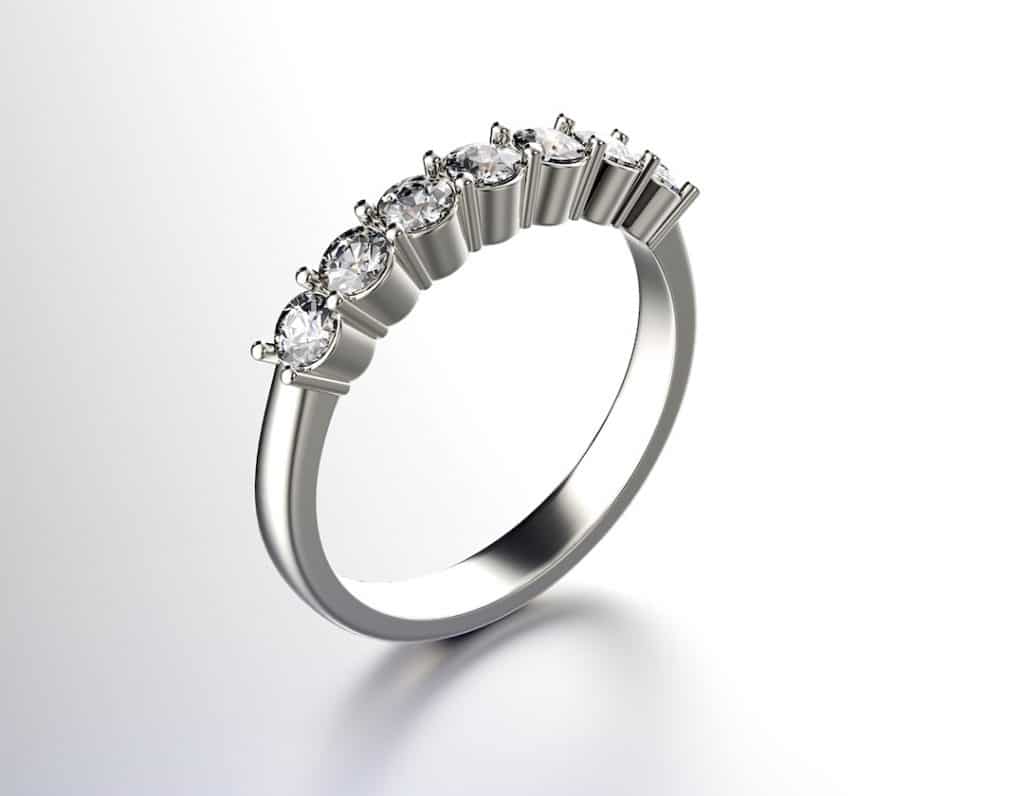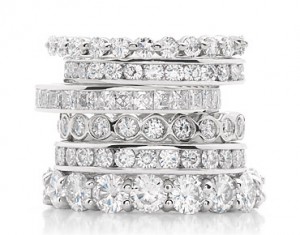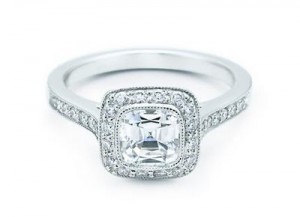 Finding the perfect ring can be a daunting task, especially if you really want a large stone in a high-end setting but don’t quite have the budget for diamonds just yet. One of the hottest new trends of the decade are the new diamond alternatives. Many brides-to-be are opting for a diamond alternative in a high quality setting as a placeholder until finances permit to upgrade to a diamond. The new diamond alternatives are getting so good at imitating the real deal that you might think twice about purchasing a mined diamond.
Finding the perfect ring can be a daunting task, especially if you really want a large stone in a high-end setting but don’t quite have the budget for diamonds just yet. One of the hottest new trends of the decade are the new diamond alternatives. Many brides-to-be are opting for a diamond alternative in a high quality setting as a placeholder until finances permit to upgrade to a diamond. The new diamond alternatives are getting so good at imitating the real deal that you might think twice about purchasing a mined diamond.
What Exactly Are Diamond Alternatives?
Simply put, diamond alternatives are any type of stone which can be used in place of a mined diamond. Because it can be a little confusing for a first time buyer, it’s important that you know a little about each option so you can make an informed purchase.
Diamond Simulants and Cubic Zirconia
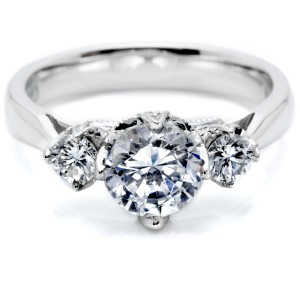 Cubic zirconia (CZ) is the most common man-made diamond alternative. Also known as a diamond simulant, it is very affordable and readily available in the jewelry industry. With dramatic increases in technology and cutting techniques, there are high grade, fine cubic zirconia stones which are extremely difficult to distinguish from a natural diamond. Although cubic zirconia has had a reputation for being a second class diamond alternative, new technology has raised the bar and created a higher-end alternative. As well, a few companies have “diamond hybrids” (cz with a layer of carbon fused on the surface) and make for beautiful and believable diamond alternatives.
Cubic zirconia (CZ) is the most common man-made diamond alternative. Also known as a diamond simulant, it is very affordable and readily available in the jewelry industry. With dramatic increases in technology and cutting techniques, there are high grade, fine cubic zirconia stones which are extremely difficult to distinguish from a natural diamond. Although cubic zirconia has had a reputation for being a second class diamond alternative, new technology has raised the bar and created a higher-end alternative. As well, a few companies have “diamond hybrids” (cz with a layer of carbon fused on the surface) and make for beautiful and believable diamond alternatives.
Pros:
- Very affordable, allowing for a higher quality setting or a larger stone where otherwise not possible.
- Optically similar to diamonds, sometimes having more fire and brilliance. The new high-grade cuts make it very difficult to tell the difference when compared to a diamond.
- High grade cubic zirconia can appear incredibly diamond-like when set in a high quality gold, platinum or palladium setting.
- Easily replaceable, no insurance or worries about loss of stone.
- No flaws or inclusions.
- Comes in a large variety of colors, imitating the expensive fancy colored diamonds.
- New technology and methods have substantially increased the quality and beauty of diamond simulants.
Cons
- Less durable than a diamond or mossianite. 8.5 on the MOH scale of hardness (with diamonds being a 10).
- Potential to cloud or darken if not cared for properly.
- Likely to need replacement after a few years of wear (especially if worn doing gardening, housework, etc).
- Social stigma (although lessening) may still exist. Many women choose not to tell others their stone is cubic zirconia.
- White or completely colorless. With only the rarest of diamonds having this quality, it may be slightly less believable.
Where to Purchase:
- Carat
- Wink CZ
- Better Than Diamond (Asha)
- MiaDonna
- Ziamond
- Diamond Nexus Labs
- QVC Diamonique
- Swarovski Pure Brilliance
Diamond Alternatives: Moissanite
Discovered by Dr. Henri Moissan, moissanite is a diamond-like stone created in a lab with the minerals carborundum and silicone carbide. It is considered an excellent diamond alternative due to its ability to mimic a diamond’s hardness, durability and fire. It is important to note that the cut and shape of the stone greatly enhance its ability to shine.
Pros:
- Affordable (much less expensive than a diamond but more than a cubic zirconia).
- Excellent luster and clarity; retains it better than cubic zirconia.
- Higher refractive index with more brilliance and fire than a cubic zirconia and diamond (especially depending on the cut).
- 9.25 on the MOH scale of hardness (with diamonds being a 10)
- Includes minor inclusions, making it appear more like a natural diamond.
- No natural fractures or cracks, making it tougher than a diamond.
Cons:
- More expensive than a cubic zirconia (but more affordable than diamonds).
- Excess fire and brilliance can give it a fake look, depending on cut and size.
- Although a clear stone, some can have a greenish/yellowish/greyish tint depending on lighting, cut and shape. More noticeable as the stone size increases.
- Not considered “real” by jewelers.
Where to Purchase:
Diamond Alternatives: Synthetic Diamonds (Lab, Man-made, Cultivated Diamonds)
 Lab created synthetic diamonds are a fairly new addition to the jewelry industry but are increasingly in popularity as a mined diamond alternative. Much like cultivated pearls, synthetic diamonds are grown from the same carbon material as mined diamonds in an environment which mimics nature– ultimately forming a true diamond. Synthetic diamonds are identical to mined diamonds and are graded as such. With the same fire, brilliance, hardness and beauty of mined diamonds, they are considered the finest diamond alternative available–they are, quite literally, diamonds.
Lab created synthetic diamonds are a fairly new addition to the jewelry industry but are increasingly in popularity as a mined diamond alternative. Much like cultivated pearls, synthetic diamonds are grown from the same carbon material as mined diamonds in an environment which mimics nature– ultimately forming a true diamond. Synthetic diamonds are identical to mined diamonds and are graded as such. With the same fire, brilliance, hardness and beauty of mined diamonds, they are considered the finest diamond alternative available–they are, quite literally, diamonds.
Pros:
- Visually and structurally identical to mined diamonds and are considered “real” diamonds.
- More affordable than natural diamonds.
- No ethical issues; 100% conflict free.
- Come in a variety of colors, making it more affordable to now purchase fancy colored diamonds.
- Technology and availability constantly improving.
Cons:
- Still fairly expensive, approximately 30% less than mined diamonds.
- White or colorless synthetic diamonds are not as readily available in large sizes
- Potential waiting lists and may not be as readily available as other diamond alternatives.
- Somewhat limited number of suppliers.
Where to Purchase:
- www.apollodiamond.com
- www.gemesis.com
- www.chatham.com
- www.created-diamonds.com
- www.takaradiamonds.com
- www.renaissancediamonds.com
- www.lucentdiamonds.com
- www.d.neadiamonds.com
_______________
Whether you opt for a diamond simulant, moissanite or a synthetic diamond, one of these options may be the perfect choice for your next jewelry purchase. The most important thing to remember is that engagement rings are symbolic of love and commitment, and there are excellent diamond alternatives on the market which will fit your budget and style.
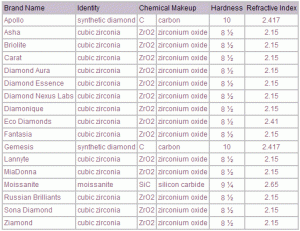
Photos courtesy of Moissanite & Diamond and Carat.

